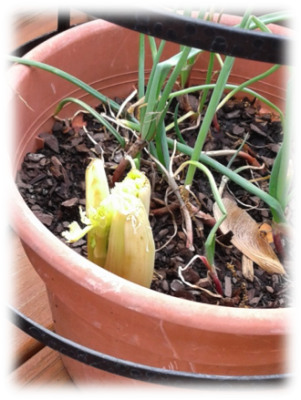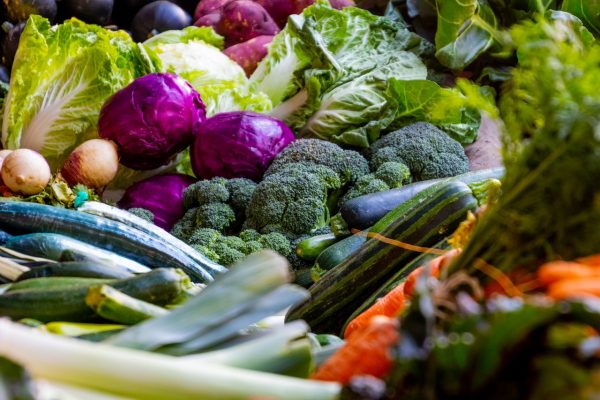Did you know that is it is possible to get far more produce out of your vegetable crisper than what you put in it? Before throwing away those unwanted kitchen scraps and heading to the grocery store to restock, you may want to give those carrot tops and celery butts a closer look. By learning how to propagate vegetable cuttings, you can actually jumpstart a new garden whether you have a green thumb or not.
Here are a few simple and economical ways to make a great project for you and your family. Try growing any of the veggies on the list below and see how easily they produce.
- Celery– After you have used the stalks and leaves on your celery, save the base end of the plant and place it in water to root or in small pot of soil and watch it regenerate new stalks. Celery is also an easy vegetable to grow indoors.
- Sweet Potatoes– Cut a third of a potato with a few eyes (the natural dimples on a potato) remaining. Bury it in a deep pot of dirt and new shoots will bud from the eye of the potato creating new plants.
- Onions / Garlic– Got an onion sprouting in the bin? Place it root side down in a pot of soil exposing part of the bulb. As the green tops or scallions grow, snip and use as desired.
- Tomatoes– Slice the tomato in round circles exposing the seeds. Place each ring on of top the potting soil, cover it with a small layer of dirt, and spritz it with a little water each day until it sprouts. Transplant when it reaches 5-6 inches tall where it can grow in a larger space. Note: Seek out heirloom varieties because hybrids seeds may not regrow.
- Romaine Lettuce– Just like the celery, save about two inches over the base end. Either place it in a shallow bowl of water to root or upcycle a produce clamshell* and let it regrow there.
- Herbs –Many herbs can be rooted from the stems if placed in a small jar of water such as cilantro, basil, oregano or sage.
- Carrots– It’s amazing how easily root vegetables like carrots can propagate themselves if you place the tops in a shallow plate of water. Once they develop new roots, transfer them to the soil to produce new plants.
- Peppers– Save the seeds from your pepper plants and tuck them into the soil to sprout, or you can start the seeds in an old egg crate. Transplant to a larger container when it reaches 3-4 inches tall.


What You’ll Need
- Banana Peel– I got this idea from watching a movie, but discovered that banana peels delivers a dose of potassium and other essential nutrients to the soil that feeds hungry plants.
- Orange Peels– This citrus scrap not only adds nutrients to the soil, but it also deters small animals from trespassing into your garden.
- Crushed Egg Shells– Dried egg shells when crushed are a great source of calcium for the plant while warding off those creepy crawly pests.
- Coffee Grounds/ Used Tea Bags– Love your java or herbal tea in the mornings? Coffee grounds and tea bags are compostable as well as a great source of nutrients for acid loving plants.
- Potting Soil – If gardening indoors, use a good organic potting soil for vegetables. According to Better Homes & Garden, the nutrients in the soil will give the veggies more flavor. But if outdoors, you can mix compost, top soil, and a good fertilizer to create a good foundation for your plants to thrive.
- Cayenne Pepper & Dish Soap–For outdoor gardens, this solution mixed with water can also keep insects and rabbits off of your vegetables.
- *Produce Clamshells –These are those hinged clear plastic containers that salad greens are sold in. Instead of tossing these out, they make great mini greenhouses to help sprout new seedlings.
- Egg Crates – Also great for starting seedlings.
- Large Plastic Storage Bins / Kiddie Pools – Both are quick and economical ways to create large containers for your patio garden. Just be sure to add a few vent holes for water drainage.
- A Sunny Spot Indoor/Outdoors for Everything to Grow – Plants get their energy from lots of natural sunlight. Look for a spot where they can get around 6-8 hours of direct sun.


Reduce Your Trips to the Grocery Store
Earth Day and warmer months are coming up so with a little patience and plenty of sunshine you can start your new plot and be kind to the planet. When I’m out at the local nursery or home improvement stores, I’m noticing more people giving thought to food they can grow at home. Creating that renewable garden not only reduces your grocery bill, but it’ll save you a few trips to the store. Besides, there’s nothing like having the convenience of fresh produce right at your fingertips when you’re ready to make that BLT sandwich or that next batch of spaghetti sauce.





6 comments
The Unexpected Garden, what great advise and so creative! I would have never thought to use such leftovers that could turn into such a wonderful little healthy garden. I will definitely keep this in mind before throwing away my used veggies. Thanks for the tip ?
Great article! Feeling inspired to add basil, onions and garlic to my garden.
What a wonderful article! You’ve inspired me to get creative in the garden and try out a few of these ideas! Thank You !
Super helpful! I’ve been trying to figure out how to make better use of my food waste and wanted to start a garden too. This helps with both, way to be healthier and more sustainable at the same time!
Hi there. I’ have planted a mini kitchen garden. Nice article Janice. My sentiments exactly. Love, Aunt Marsha.
Great article… it’s amazing to see you can start a garden using veggies and foods that you are discarding. Thanks for the helpful tips!
Comments are closed.